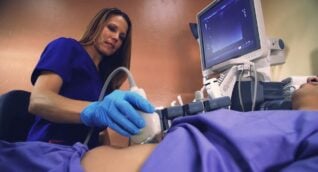An aortic aneurysm screening is an exam to see if an aneurysm (an abnormal bulging of the vessel wall) has developed the in wall of the abdominal aorta, a large blood vessel that exits from the heart to supply blood to your entire body. The main risks associated with aortic aneurysm are rupture, dissection (tears between aortic wall layers), and blood clots. A ruptured aortic aneurysm is a life-threatening situation, which is why a screening is recommended for those at risk.
Aortic aneurysm screening is done before symptoms are present to detect a problem before serious complications occur. Ultrasound is a safe, non-invasive way to detect abdominal aortic aneurysms, and the procedure does not expose you to ionizing radiation (X-rays). The exam uses a special probe called a transducer that transmits and receives sound waves to visualize the aorta shape, contour, and blood flow.
More basic information on ultrasound is available in the About Ultrasound section.
If detected early, abdominal aortic aneurysm can be corrected before life-threatening rupture occurs. Risk factors for abdominal aortic aneurysm are:
- Age over 65 years
- Male gender
- A history of tobacco use
- Being Caucasian
- A family history of abdominal aortic aneurysm
- Atherosclerosis (“hardening of the arteries”)
- Aneurysms in other parts of the body
- High blood pressure
The US Preventative Task Force abdominal aortic aneurysm screening recommendations are:
- One-time screening recommended for men ages 65 to 75 who have ever smoked.
- Selective screening for men ages 65 to 75 who have never smoked. Your doctor may recommend screening based on other risk factors.
- For women ages 65 to 75 who have ever smoked, there is not enough scientific evidence to make a firm recommendation.
- For women who have never smoked, abdominal aortic ultrasound is not recommended.
Ask your doctor if abdominal aortic aneurysm screening is appropriate for your age and risk profile.
Benefits
- Abdominal aortic aneurysm screening is an inexpensive, fast, and non-invasive way to detect a potentially life-threatening disorder of the aorta.
- Ultrasound does not expose you to ionizing radiation (X-rays).
- Unlike MRI, ultrasound can be used in patients with any type of metal in their body, including implantable medical devices.
- Ultrasound is very safe and has no side effects.
- There is no need to administer contrast for ultrasound exams.
- Ultrasound can detect soft tissue abnormalities that cannot be visualized with regular X-ray exams.
Risks
- The use of diagnostic ultrasound (without biopsy) has no known risks or harmful effects. Ultrasound exams are safe at any stage of pregnancy.
- Any diagnostic test may lead to the recommendation of other tests, procedures, or surgery that may carry risks.
- Aortic aneurysm screening is done in an ARA outpatient imaging center. The exam will take about 30 minutes and you will be in the imaging center for about an hour.
- You may be asked to change into a gown.
- You will be placed lying on your back on an exam table.
- A water-based gel will be placed on your abdominal area. The gel creates a sealed contact between your skin and the ultrasound probe. This eliminates any air pockets that may interfere with imaging. The probe will be moved around to capture images from different locations. The gel does not stain clothing.
- The technologist or radiologist performing the study may have to apply pressure with the probe to the body part being examined.
- A Doppler ultrasound may be performed with the same probe. You may hear pulsation sounds during this part of the exam.
- The gel is wiped off of your skin.
- You can return to your normal activities after the exam is over.
- You may need to avoid eating for 8 to 12 hours before the procedure. Your scheduler will inform you of the requirements.
- Wear comfortable, loose-fitting clothing to your ultrasound exam.
To schedule an aortic aneurysm screening, please use our online scheduling tool in the Patient Portal or you may call our scheduling team at (512) 453-6100 or toll free at (800) 998-8214. A referral from your healthcare provider is required to make an appointment.
A radiologist, a physician specifically trained to interpret radiological examinations, will analyze the images and send a signed report to the provider who referred you to ARA. The physician will then share the results with you.

